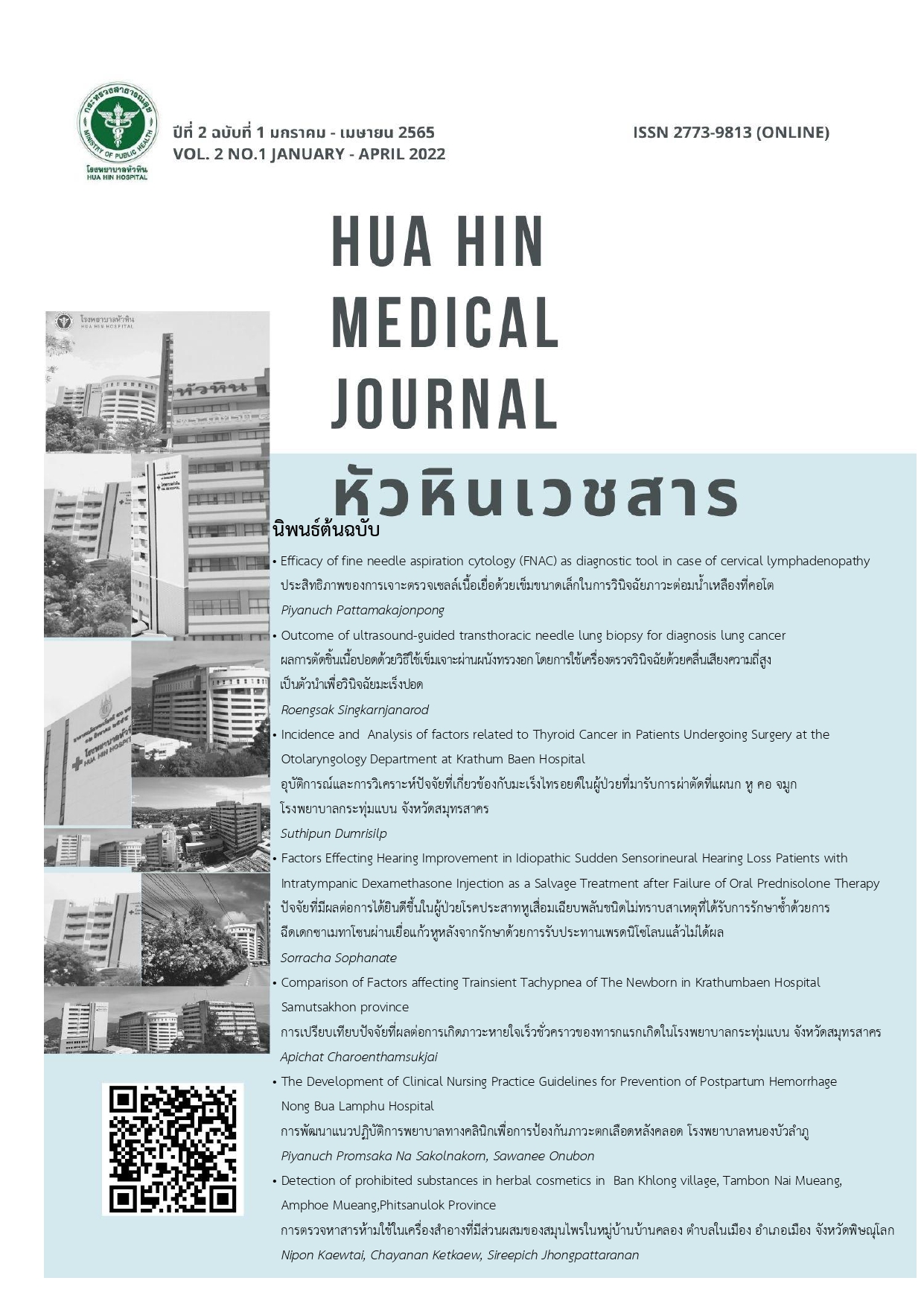Outcome of ultrasound-guided transthoracic needle lung biopsy for diagnosis lung cancer
Keywords:
lung cancer, needle lung biopsy, peripheral lung massAbstract
Introduction: The lung cancer is one of most common types of cancers and the leading cause of death in Thailand. Diagnosis and treatment of lung cancer requires a lung biopsy for pathological examination. A lung biopsy can be performed in several ways, each with different efficacy and complications. The choice of lung biopsy method depends on the location of the mass, the size and the patient's clinical condition.
Objective: This study was aimed to investigate the diagnostic value and the complications of ultrasound-guided transthoracic needle lung biopsy for the diagnosis of lung cancer in patients suspected of lung cancer from chest computed tomography (CT)
Methods: This was a retrospective study of the patients suspected of lung cancer with peripheral lung or mediastinal mass from CT image who received treatment at the Internal Medicine outpatient clinic, Ratchaburi Hospital from November 1, 2019 to September 30, 2021. The patients had undergone ultrasound-guided transthoracic needle lung biopsy to determine the incidence of lung cancer diagnosis from the procedure and factors related to cancer detection.Results: 141 patients were included, 101 were male and the mean age was 61.4 years old. The lung biopsy result come back positive for malignancy in 126 patients, 13 patients with benign lung tissue and 2 patients with necrotic features. Incidence of lung cancer detected from the procedure was 89.4%. 3 patients had hemoptysis and one patient had pneumonia after the procedure. We found that lung cancer detection from this method is associated with patients with lung mass greater than 5 cm. and the located at upper lobe of the lung or mediastinum Conclusion: Ultrasound-guided transthoracic needle lung biopsy is effective and safe for diagnosis lung cancer in patients suspected of lung cancer with peripheral lung or mediastinal mass from CT image and more specified in cases of lung mass greater than 5 cm. and the located at upper lobe of the lung or mediastinumKey words: lung cancer, needle lung biopsy, peripheral lung mass
References
เอกสารอ้างอิง
แนวทางการตรวจวินิจฉัยและรักษาโรคมะเร็งปอด (ปรับปรุงครั้งที่ 2) –กรุงเทพฯ :สถาบันมะเร็งแห่งชาติ กรมการแพทย์ กระทรวงสาธารณสุข;พ.ศ. 2558.
ทะเบียนมะเร็งระดับโรงพยาบาล พ.ศ. 2563 Hospital-Based Cancer Registry 2020. –กรุงเทพฯ :สถาบันมะเร็งแห่งชาติ กรมการแพทย์ กระทรวงสาธารณสุข; พ.ศ. 2564.
Bronchoscopic techniques in diagnosis and staging of lung cancer.
F.J.F. HerthBreathe 2011;7:324-337[Online]. [cited 21 December 2021]. Available from: https://breathe.ersjournals.com/content/breathe/7/4/324.full.pdf
Michele Anzidei, Andrea Porfiri, Fabrizio Andrani, et all. Imaging-guided chest biopsies: techniques and clinical results.
Insights Imaging 2017;8:419–428
Rashid A. Khan, Vinod Kumar, Muhammad Taimur, et all. Diagnostic Yield of Ultrasound-guided Trucut Biopsy in Diagnosis of Peripheral Lung Malignancies.
Cureus2019;11(6):412-415
Matthew H. Lee, Meghan G. Lubner, J. Louis Hinshaw, et all. Ultrasound Guidance Versus CT Guidance for Peripheral Lung Biopsy: Performance According to Lesion Size and Pleural Contact.
AJR 2018; 210:W110–W117
Yannick Simonneau, Julia Ballouhey, Gilles Mangiapan, et all. Ultrasound-guided lung biopsies performed by pulmonologist: a French prospective study.
European Respiratory Journal 2019 54: PA4833
Norio Yamamoto, Tetsuya Watanabe, Kazuhiro Yamada, et al. Efficacy and safety of ultrasound (US) guided percutaneous needle biopsy for peripheral lung or pleural lesion: comparison with computed tomography (CT) guided needle biopsy.
J Thorac Dis 2019;11(3):936-943
Downloads
Published
How to Cite
Issue
Section
License
Copyright (c) 2022 Hua-Hin Hospital

This work is licensed under a Creative Commons Attribution-NonCommercial-NoDerivatives 4.0 International License.
บทความที่ได้รับการตีพิมพ์ในวารสารหัวหินเวชสาร เป็นลิขสิทธิ์ของโรงพยาบาลหัวหิน
บทความที่ลงพิมพ์ใน วารสารหัวหินเวชสาร ถือว่าเป็นความเห็นส่วนตัวของผู้เขียนคณะบรรณาธิการไม่จำเป็นต้องเห็นด้วย ผู้เขียนต้องรับผิดชอบต่อบทความของตนเอง







